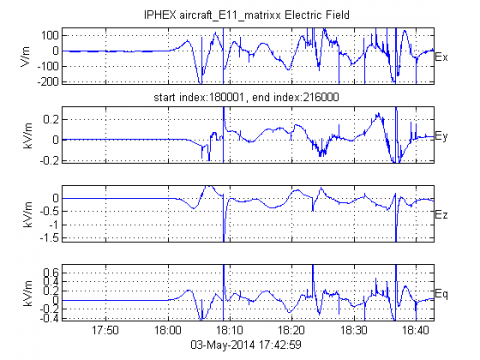 The NASA Global Hydrology Resource Center (GHRC) DAAC published the GPM Ground Validation Lightning Instrument Package (LIP) IPHEx dataset. This dataset consists of electrical field measurements of lightning and navigation data collected by the Lightning Instrument Package (LIP) flown aboard a NASA ER-2 high-altitude aircraft during the GPM Ground Validation Integrated Precipitation and Hydrology Experiment (IPHEx) held in North Carolina. The goal of IPHEx was to evaluate the accuracy of satellite precipitation measurements and use the collected data for hydrology models in the region. These data files are available in ASCII format and browse imagery in PNG format from May 1, 2014 through June 14, 2014. It should be noted that this dataset is not continuous as flights did not occur every day.
The NASA Global Hydrology Resource Center (GHRC) DAAC published the GPM Ground Validation Lightning Instrument Package (LIP) IPHEx dataset. This dataset consists of electrical field measurements of lightning and navigation data collected by the Lightning Instrument Package (LIP) flown aboard a NASA ER-2 high-altitude aircraft during the GPM Ground Validation Integrated Precipitation and Hydrology Experiment (IPHEx) held in North Carolina. The goal of IPHEx was to evaluate the accuracy of satellite precipitation measurements and use the collected data for hydrology models in the region. These data files are available in ASCII format and browse imagery in PNG format from May 1, 2014 through June 14, 2014. It should be noted that this dataset is not continuous as flights did not occur every day.GHRC News
 The NASA Global Hydrology Resource Center (GHRC) DAAC published the GPM Ground Validation Lightning Instrument Package (LIP) IPHEx dataset. This dataset consists of electrical field measurements of lightning and navigation data collected by the Lightning Instrument Package (LIP) flown aboard a NASA ER-2 high-altitude aircraft during the GPM Ground Validation Integrated Precipitation and Hydrology Experiment (IPHEx) held in North Carolina. The goal of IPHEx was to evaluate the accuracy of satellite precipitation measurements and use the collected data for hydrology models in the region. These data files are available in ASCII format and browse imagery in PNG format from May 1, 2014 through June 14, 2014. It should be noted that this dataset is not continuous as flights did not occur every day.
The NASA Global Hydrology Resource Center (GHRC) DAAC published the GPM Ground Validation Lightning Instrument Package (LIP) IPHEx dataset. This dataset consists of electrical field measurements of lightning and navigation data collected by the Lightning Instrument Package (LIP) flown aboard a NASA ER-2 high-altitude aircraft during the GPM Ground Validation Integrated Precipitation and Hydrology Experiment (IPHEx) held in North Carolina. The goal of IPHEx was to evaluate the accuracy of satellite precipitation measurements and use the collected data for hydrology models in the region. These data files are available in ASCII format and browse imagery in PNG format from May 1, 2014 through June 14, 2014. It should be noted that this dataset is not continuous as flights did not occur every day.
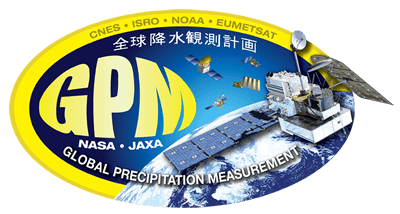 |
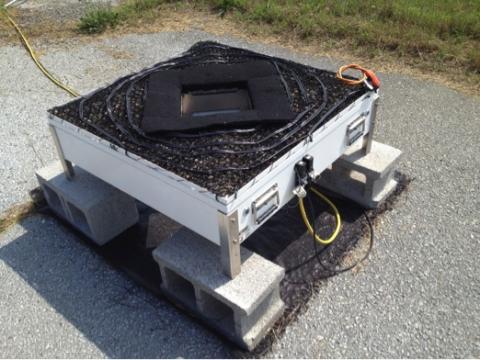 |
The NASA Global Hydrology Resource Center (GHRC) DAAC published the GPM Ground Validation Two-Dimensional Video Disdrometer (2DVD) C3VP dataset. This dataset consists of snowfall data collected by the Two-Dimensional Video Disdrometer (2DVD) during the Canadian CloudSat/CALIPSO Validation Project (C3VP) field campaign. The campaign took place in southern Canada in support of multiple science missions, including the NASA GPM mission, in order to improve the modeling and remote sensing of winter precipitation. The 2DVD measures precipitation characteristics such as size, shape, and velocity. During C3VP, there was one 2DVD instrument deployed at the Meteorological Service of Canada (MSC) operated Centre for Atmospheric Research Experiments (CARE) facility in Ontario, Canada. The data include diameter, volume, and fall speed information for individual snowflakes. The dataset files are available in ASCII text format from December 2, 2006 through April 9, 2007.
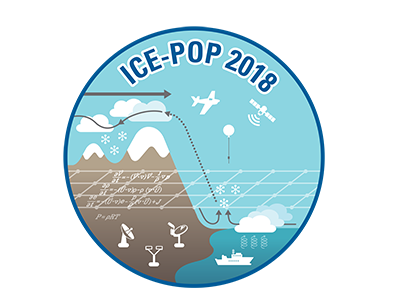 The NASA Global Hydrology Resource Center (GHRC) DAAC published the GPM Ground Validation SEA FLUX ICE POP dataset. This dataset includes estimates of ocean surface latent and sensible heat fluxes, 10m wind speed, 10m air temperature, 10m air humidity, and skin sea surface temperature in support of the International Collaborative Experiments for Pyeongchang 2018 Olympic and Paralympic Winter Games (ICE-POP) field campaign in South Korea. The two major objectives of ICE-POP were to study severe winter weather events in regions of complex terrain and improve the short-term forecasting of such events. These data contributed to the Global Precipitation Measurement mission Ground Validation (GPM GV) campaign efforts to improve satellite estimates of orographic winter precipitation. This data file is available in netCDF-4 format from September 1, 2017 through April 30, 2018.
The NASA Global Hydrology Resource Center (GHRC) DAAC published the GPM Ground Validation SEA FLUX ICE POP dataset. This dataset includes estimates of ocean surface latent and sensible heat fluxes, 10m wind speed, 10m air temperature, 10m air humidity, and skin sea surface temperature in support of the International Collaborative Experiments for Pyeongchang 2018 Olympic and Paralympic Winter Games (ICE-POP) field campaign in South Korea. The two major objectives of ICE-POP were to study severe winter weather events in regions of complex terrain and improve the short-term forecasting of such events. These data contributed to the Global Precipitation Measurement mission Ground Validation (GPM GV) campaign efforts to improve satellite estimates of orographic winter precipitation. This data file is available in netCDF-4 format from September 1, 2017 through April 30, 2018.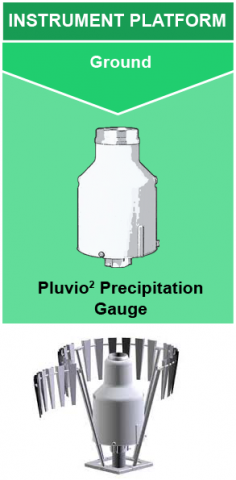 The NASA Global Hydrology Resource Center (GHRC) DAAC published the Pluvio2 Precipitation Gauge instrument micro article. This can observe rain, snow, sleet, and hail. The Pluvio2 is a weighing precipitation gauge that determines both the rate and amount of precipitation by determining its weight. This is done through measuring electrical signals created by the force of the weight of the collection bucket. The instrument includes filter algorithms to reduce the effects of wind, temperature, and evaporation on measurement accuracy. The Pluvio2 has been used for a variety of purposes including precipitation studies, flood monitoring, and instrument calibration. This micro article provides an overview of the Pluvio2 and its applications to support current and future GHRC dataset publications. The micro article is available at: https://ghrc.nsstc.nasa.gov/home/micro-articles/instrument-pluvio%C2%B2-precipitation-gauge
The NASA Global Hydrology Resource Center (GHRC) DAAC published the Pluvio2 Precipitation Gauge instrument micro article. This can observe rain, snow, sleet, and hail. The Pluvio2 is a weighing precipitation gauge that determines both the rate and amount of precipitation by determining its weight. This is done through measuring electrical signals created by the force of the weight of the collection bucket. The instrument includes filter algorithms to reduce the effects of wind, temperature, and evaporation on measurement accuracy. The Pluvio2 has been used for a variety of purposes including precipitation studies, flood monitoring, and instrument calibration. This micro article provides an overview of the Pluvio2 and its applications to support current and future GHRC dataset publications. The micro article is available at: https://ghrc.nsstc.nasa.gov/home/micro-articles/instrument-pluvio%C2%B2-precipitation-gauge
 The NASA Global Hydrology Resource Center (GHRC) DAAC published the NASA S-band Dual Polarimetric Radar (NPOL) instrument micro article. The NPOL is a research grade dual polarimetric Doppler radar with equivalent capabilities to the Doppler radars of the U.S. National Weather Service’s Next Generation Weather Radar (NEXRAD) network. Unlike the NEXRAD radars, NPOL is one of two completely transportable, research-grade S-band radar systems in the world. When not on deployment, it resides and operates near NASA’s Wallops Flight Facility. NPOL has been used for a variety of research purposes include satellite precipitation validation, precipitation studies, and precipitation microphysics. This micro article provides an overview of NPOL and its applications to support current and future GHRC publications. The micro article is available at: https://ghrc.nsstc.nasa.gov/home/micro-articles/instrument-nasa-s-band-dual-polarimetric-radar-npol
The NASA Global Hydrology Resource Center (GHRC) DAAC published the NASA S-band Dual Polarimetric Radar (NPOL) instrument micro article. The NPOL is a research grade dual polarimetric Doppler radar with equivalent capabilities to the Doppler radars of the U.S. National Weather Service’s Next Generation Weather Radar (NEXRAD) network. Unlike the NEXRAD radars, NPOL is one of two completely transportable, research-grade S-band radar systems in the world. When not on deployment, it resides and operates near NASA’s Wallops Flight Facility. NPOL has been used for a variety of research purposes include satellite precipitation validation, precipitation studies, and precipitation microphysics. This micro article provides an overview of NPOL and its applications to support current and future GHRC publications. The micro article is available at: https://ghrc.nsstc.nasa.gov/home/micro-articles/instrument-nasa-s-band-dual-polarimetric-radar-npol





